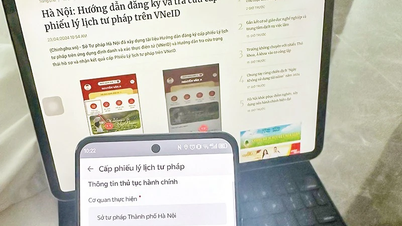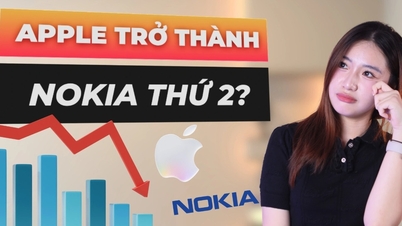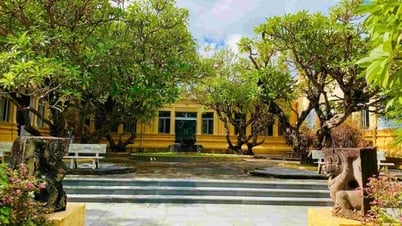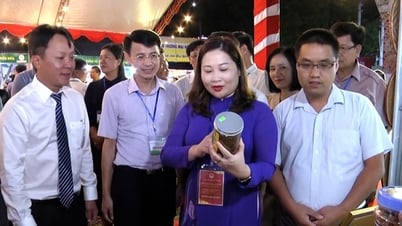
The image depicts a girl being tricked into clicking on a strange message.
With just a few tools publicly advertised online, criminals can easily send out a series of messages impersonating major banks.
These messages are designed to look exactly like official messages from the bank, making it difficult for users to distinguish. The content often plays on the victim's fear with warnings such as "account locked", "unauthorized login", along with the request to "click here to check".
Panic or curiosity is the reason why many people fall into traps, unwittingly helping criminals.
Short link, long consequences
With just one click of a link in a message , users can fall into a pre-set trap. The fake website is often elaborately designed, copying the real bank interface down to every detail: logo, color, layout, and all are carefully invested to appeal to the feeling of familiarity.
Just by entering the username, password or OTP code, the fraudster can almost immediately take control of the bank account . In many cases, the whole process takes place within minutes, from the time the user enters the information until the money in the account disappears without a trace.
Not stopping there, with the collected personal information such as citizen identification number, address, email, the scammer can continue to register for online loans, open virtual accounts, or even commit illegal acts under the name of the victim.
A link looks harmless, short, simple, often shortened by tools like bit.ly, vn.link, tinyurl… but behind it is a long chain of consequences, from losing money to affecting honor and legality. And when the victim realizes it, it is too late: the money is gone, the crook disappears, and tracing the journey of a click is almost impossible.
When technology is abused
The irony is that technological utilities created to serve users, such as branded SMS or websites with friendly interfaces, are becoming powerful tools in the hands of criminals.
Nowadays, instead of sending messages from strange phone numbers, high-tech criminals can make the messages appear under the name "Techcombank", "Vietcombank" or " MBBank " exactly like the official messages you have received before from the bank.
This is not difficult to do, because international text messaging services allow you to register brand names and send bulk SMS messages at low cost, with almost no need for verification.
From a message, the scammer leads the user to a sophisticated fake website. The interface looks no different from the real bank website with the same colors, the same logo, and even a "security" lock bar on the browser.
The only difference is the website address, but it is difficult for ordinary users to recognize. Many domain names such as vietcombank-login.com or techmbank-support.net are bought for tens of thousands of dong but bring in tens of millions from each victim.
In addition, scammers also use automation tools such as chatbots or fast-response AI , making users think they are talking to a real operator. When anyone is suspicious, these "virtual assistants" will immediately reassure them with pre-programmed answers such as: "This is the bank's new security system", or "Please confirm information to avoid account lock".
Tackling and tracking these scam groups is not easy. Many fake messaging systems and websites are operated through anonymous servers (proxies) located overseas. By the time they are discovered, even if the bank warns them, the scammers have already erased their traces or moved to a new domain name.
Attack technology is no longer manual - it operates like a business model: there are roles, web designers, chatbot operators, and "closers" when the victim has fallen into the trap.
Technology is inherently neutral. But in an uneven race, bad guys are exploiting it much faster and more powerfully than ordinary users. And as technology gets smarter, the traps become harder to spot.
Protect yourself from technology scams
First of all, users need to keep a simple but important rule: never click on any strange links in messages, emails or calls that you do not know the source, even if it appears under a familiar bank name. Technology makes it easier than ever to fake brand names, so "familiar" does not mean "trustworthy".
When you receive messages notifying you that your account is locked, that someone has logged in, or that you need urgent verification, you should stop, stay calm, and call the bank's official hotline number directly (find it on the actual banking website or app, not in the message). Just a minute of checking can save you from major damage.
Another important thing is to never share OTP codes , passwords, or personal information such as CCCD numbers via phone, email or strange websites. OTP (one-time authentication code) is the final "key" for criminals to take over your account - if you keep it, they can't do anything else.
In addition, you should proactively install the official banking application from the App Store or Google Play, avoiding downloading from external links. You should enable two-factor authentication (2FA) if possible, to increase the protection layer. Major banks now have the feature of transaction notifications right on the app - check regularly to detect abnormalities.
Finally, if you accidentally click on a link or provide information, immediately notify the bank and lock your account. The sooner the better. Many cases are saved because of quick action, while those who hesitate often find out when the account has "evaporated".
Source: https://tuoitre.vn/tin-nhan-mao-danh-cong-nghe-giup-ke-gian-goi-von-20250609141427371.htm




































































































Comment (0)